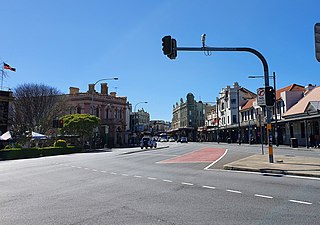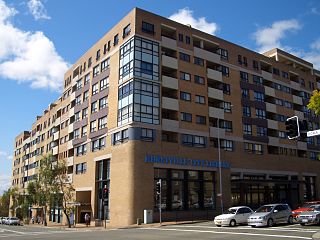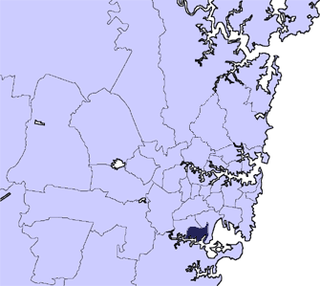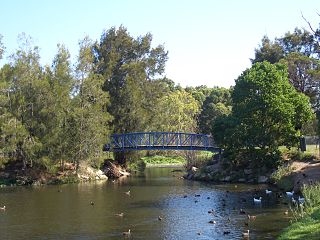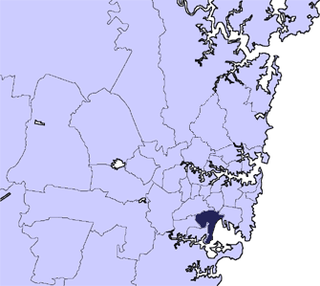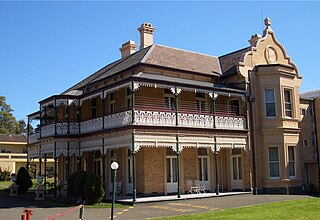History
The parcel of land on which Lydham Hall stands was part of the original 1200 acres land granted by Governor Ralph Darling to James Chandler on 19 October 1831, which was named Bexley. Chandler's agricultural ventures were not successful and eventually the property was mortgaged, subdivided and sold.
On 1 November 1859, wealthy master butcher, Joseph Davis bought 67 of Chandler's original grant. Davis' property was used for resting and fattening cattle before slaughtering them in his Arncliffe slaughter-house and boiling down work on land he purchased six months earlier. [2]
Joseph Davis was born in the village of Brede in Sussex in 1826, came to New South Wales in 1847 and set up business in Newtown, possibly first as a publican and then as a butcher. On 28 October 1850, he married 17 year old Ellen Turner at Scots Church, Sydney. They had seven children, all born between 1851 and 1875.
Davis was also a prominent man in Bexley and a generous benefactor to Christ Church, Bexley. He was one of the petitioners who advocated for the established of a local school in the area in 1887. This educational establishment known now as Bexley Public School opened in 1888. [1]
Davis engaged local Swedish stonemasons, the Benson brothers, to construct a house on the highest point of the estate to have sweeping views of Botany Bay. The house was built "sometime between 1872 and 1879 with its completion and house-warming party taking place between 10 June 1878 and 10 June 1879 or very shortly afterwards." [1]
In 1882, Davis applied to convert the land to Torrens Title, and began to subdivide and sell his land. The streets formed as a result of this subdivision were named after Davis's two youngest sons, Frederick and Herbert, and his eldest grandson, Clarence.
After Joseph Davis' death, Mrs Ellen Davis finalised the subsequent subdivision and sold Lydham Hill to Frederick Gibbins, a successful oyster merchant and trawling magnate, who lived nearby at Dappeto (now known as Macquarie Lodge). Ellen Davis moved back to Newtown and died at Kensington House, 98 Wilson Street, Newtown, in 1906. Davis' second son, also Joseph Davis, ran the original butcher's shop at 255-257 King Street, Newtown, NSW. [2]
Gibbins leased out Lydham Hill up until 1907. When his daughter Ada married David George Stead, a widower and father of Australian writer Christina Stead, the newly-weds settled in Lydham Hill then for a little rent. [2]
David Stead was a world renowned naturalist. Born on 6 March 1877 he left school at the age of 12 and began working as an apprentice to a rubber stamp maker. His scientific career began with a zoology course at Sydney Technical College. At the age of 21, he joined the Linnean Society of New South Wales and by 1900 he had written several short articles that were published by the Society. Stead's special field was in marine life and this was recognised in when he was offered employment in 1902 as a scientific assistant under the Director of Fisheries for the Commonwealth. Stead was also an outspoken conservationist and in 1909 he co-founded the Wildlife Preservation Society of Australia.
David Stead had previously been married to Ellen Butter and on 17 July 1902 they had a daughter, Christina Stead. Ellen died on 9 December 1904 while pregnant with their second child due to the complications of a perforated appendix. [3]
Christina Stead was and is still regarded by many as one of Australia's greatest and the most esteemed writers. She was born on 17 July 1902 in a cottage in Kimpton Street, then Rockdale (now Banksia). Christina moved into Lydham Hall with her father and his second wife Ada. During the following ten years, Ada gave birth to six children. A great storyteller, young Christina would entertain her half brothers and sisters with tales and poems. A few of Christina's short stories and her most known and popular work, "The Man Who Loved Children" were based on her experiences while living in Lydham Hall in 1910-1917. [2] [4]
Christina did not begin her schooling until she was seven and was regarded as an excellent student during her years at Bexley Public School. She continued her education at Kogarah Intermediate, which became known as St George Girls High School in 1916. Lydham Hall is the only house in Australia open to the public where Christina Stead lived. [4]
Frederick John Gibbins died in 1917 and left no particular instructions for Lydham Hill. Dealings with all his properties were left at the discretion of the executors of his Will, oldest daughter Emma (Pattison) and son-in-law and accountant, husband of Gibbins' daughter Amy, Mr William Thom. Thom and Pattison subdivided and sold both, Dappeto and Lydham Hill therefore the Steads moved to Watson Bay. Sometime between 1917 and the mid 1920s, the property became known as Lydham Hall.
Purchased by the then Rockdale Municipal Council in 1970 as part of the Rockdale Municipality Centenary Celebration, it became a home to the first and only local Museum within the area. The Museum houses a collection consisting of items donated to the St George Historical Society by the local and wider community, and also displays furniture on loan from the National Trust of Australia (NSW). The establishment of the Museum and building of its collection became the largest social project that combined the efforts of the local residents, the general public and the local Council under the leadership of the St George Historical Society Inc. [5]



